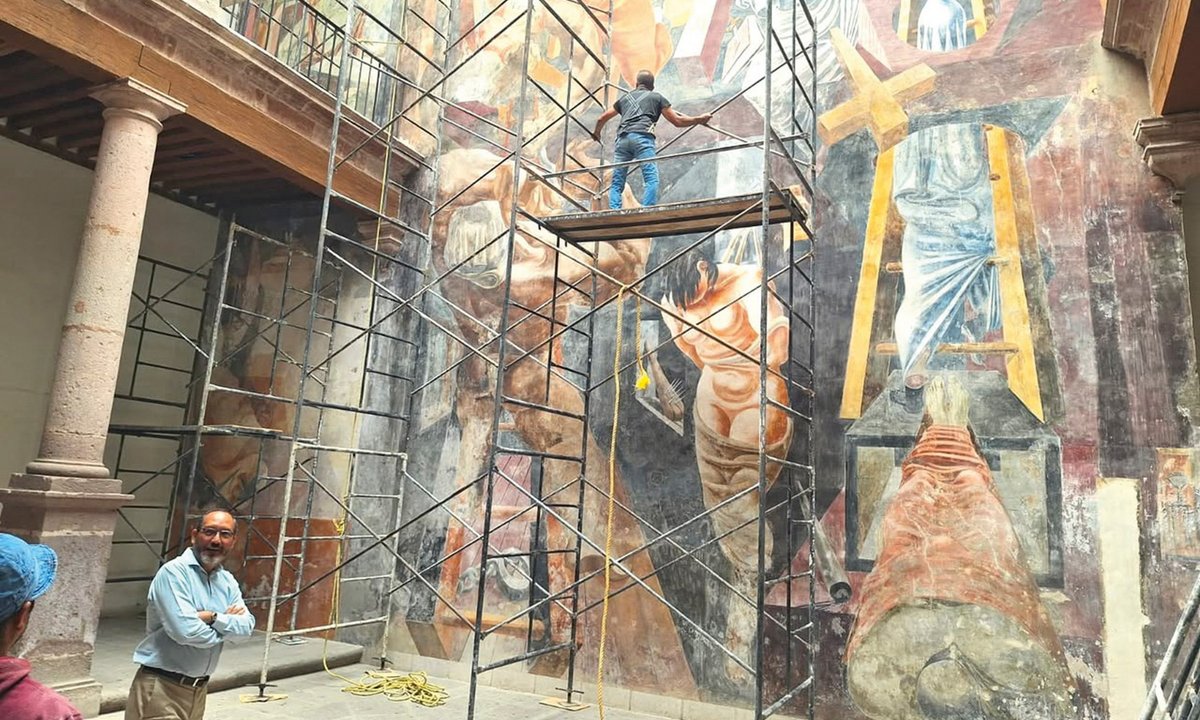“A work of staggering complexity”: restoration of the 1,024 sq. ft Mexican mural in progress last year Courtesy Museo Regional Michoacano, Morelia
The only Mexican mural painted by Philip Guston, with Reuben Kadish and Jules Langsner, will be unveiled this spring after a restoration project more than two decades in the planning.
The Struggle Against Terrorism, also known as The Struggle Against War and Fascism, first went on show shortly after it was completed by Guston—who at the time was still using his birth surname of Goldstein—Kadish and Langsner in February 1935. The mural, which was hidden behind a fake wall for 40 years, is located in an 18th-century mansion built by the Spanish in 1785 that now houses the Museo Regional Michoacano Dr Nicolás León Calderón in Morelia, the capital of the state of Michoacán.
The huge work covers an entire wall of an inner patio and measures around 1,024 sq. ft. While Guston is credited by the scholar Ellen Landau as “probably responsible for devising the key imagery” and painting the most controversial elements including members of the Ku Klux Klan, Kadish secured the commission thanks to his previous work assisting David Alfaro Siqueiros.
Siqueiros, one of Mexico’s “Los Tres Grandes”—the trio of muralists that also included Diego Rivera and José Clemente Orozco—became aware of Kadish’s talent when the young art student helped out while Siqueiros worked on the Olvera Street mural Tropical America in Los Angeles. Before leaving for Mexico in late 1934, Kadish and Guston worked together on a series of murals at Los Angeles’s John Reed Club.
In a preview of what was to come in Mexico, the John Reed Club works—influenced by the pair’s commitment to social justice, with scenes highlighting civil rights issues aimed at working class audiences—were denounced as promoting Communist ideals and, in February 1933, partially destroyed by a Los Angeles Police Department captain. Kadish told the art historian Stephen Polcari that Siqueiros was originally offered the commission in Morelia but declined and recommended the young Americans after Kadish sent him photographs of the murals at the John Reed Club.
Perhaps the fact that there was no stipend—the university that controlled the building at the time only offered to cover the $70 cost of the materials—had a bearing on Siqueiros’s decision. But that did not stop the younger artists from buying a beaten-up old car and driving to Morelia with their friend Langsner, a poet and future art critic, who came along “to mix the paints”.
On arriving in Morelia in August 1934, they were confronted by the huge wall, as well as a turbulent political and social climate. Mexico was still
recovering from the revolution less than 20 years before and had recently elected a relatively forward-thinking president, Lázaro Cárdenas, behind whom the university’s rector had thrown his support.
Philip Guston, Reuben Kadish and their friend Jules Langsner in front of their mural, The Struggle Against Terrorism, around 1934 Courtesy of The Guston Foundation
In just six months, Guston and Kadish, two young men who had not only bonded over art but had similar backgrounds—both their families had sought refuge in North America from antisemitism in Ukraine and Lithuania respectively—produced a work of staggering complexity. The work, known to locals as “The Inquisition”, encompasses several sections, necessitated in part as the work is bisected by a balcony running around the patio at an upper level.
Several bodies are depicted bound and hanging by nooses, which has been suggested is a recollection of the moment the ten-year-old Guston found his father’s hung body, as well as an allusion to the lynchings and other acts of racist terrorism still common in the US at the time. The mural’s horrific torture scenes represented both the Inquisition perpetrated by the European conquistadors and crimes committed by modern governments in the 20th century. Time magazine ran an article about the mural, and the finished work, while controversial in both the US and Mexico, boosted Guston and Kadish’s careers.
It is not known if either artist was aware that at some time in the 1940s, the then director of the museum was believed to have ordered that the work be covered with a fake wall made out of canvas stretched over a wooden frame. Whether this was to quell threats of destruction that had been levelled from some quarters or to defuse some other risk remains unclear. It only saw the light of day again in 1973 after works to fix a leak in the building revealed the mural, which had suffered badly from humidity in the intervening decades.
Eugenio Mercado López, a former director of the Museo Regional Michoacano, tells The Art Newspaper that several attempts to begin a restoration programme had been made over the years. The current project has been jointly financed by the Guston Foundation and Mexico’s Instituto Nacional de Antropología e Historia (INAH). The project’s budget has not been made public, but unconfirmed reports put the cost of the work at 1.7m pesos (around $82,000). The restored mural in Morelia is to be unveiled at a ceremony on 31 January.
“When I first travelled to see the mural in 2006, its former power could only be imagined.” Musa Mayer, Guston’s daughter, said in a statement. “I am deeply grateful to all those whose diligent work has brought this extraordinary early work back to life. Its message is as relevant today at it was 90 years ago.”
Speaking in a personal capacity, the artist Richard Pitts, a board member of the US-based Reuben Kadish Art Foundation, tells The Art Newspaper he was pleased to hear the restoration project is nearing completion. He believes news of the mural’s return to the spotlight has prompted an increase in interest in the work of Kadish, who briefly painted for the US Works Progress Administration before leaving his practice for several years and then returning to work as a sculptor.
“Kadish was a unique and original artist,” Pitts says. “His murals in Mexico and California were an early platform for exploration … and I’m glad more people will be able to see them in person.”
The long-delayed London survey is a revelatory tour de force that charts the twists and turns of the Canadian-American artist's 50-year career
The museums should make urgent use of the delay already caused by the pandemic rather than lurch towards lengthy postponement
The delay allowed the show's curators to travel and conduct further research about the Ku Klux Klan works, organisers say
As chief restorer of Andorra and consultant to Unesco, Guillamet was invited to save these murals. Months later, as revolution brewed, the paintings were abandoned. Seventeen years later, and this remains the case

